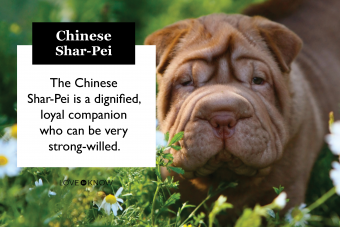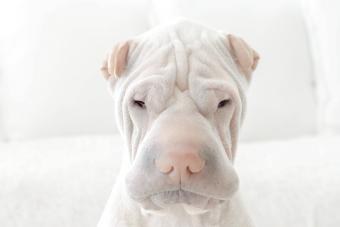
The unique look of the Chinese Shar-Pei sets it far apart from other dog breeds. If you've never seen one of these fascinating canines, take a closer look at their traits and characteristics.
Origin of the Chinese Shar-Pei
The Chinese Shar-Pei is a very ancient breed, with references and images of them recorded as far back as the Han Dynasty in China circa 200 B.C. This breed nearly became extinct after the communist revolution in China, but a few Shar-Pei were transported to Taiwan and Hong Kong. There they were bred in numbers just large enough to keep them from being wiped off the map.
Chinese Shar-Pei made their debut in the United States around 1966, and their unusual looks quickly garnered a lot of attention. They earned the nickname "Chinese fighting dog," as the breed was often used for dog fighting. The Shar-Pei's popularity reached fever pitch in the 1980s after the Guinness Book of Records named them the world's rarest dog in 1978. People's interests were piqued, and many decided they needed to have one of these wrinkled curiosities.
Notable Breed Types
A pint-sized version of the Chinese Shar-Pei exists: the Miniature Shar-Pei. These mini dogs are reportedly closer to the true size of a traditional Shar-Pei, though they are not recognized by the American Kennel Club (AKC) as a distinct breed.
Characteristics
At first glance, the lovable Chinese Shar-Pei appears to resemble a wrinkly hippopotamus more than a canine. This breed has unusual traits that set them apart from other dogs.

Appearance
In general, males are larger than females and stand about 19 to 20 inches tall at the withers. Most members of this breed weigh in between 45 and 60 pounds and have a sturdy build.
The head of a Shar-Pei has a rather broad, blunt muzzle, and the small eyes are hooded within wrinkles of flesh. The ears are quite small in comparison to the size of the head and are held folded over. The neck, chest, and back are also covered in wrinkles, and the tail is set high on the rear and carried curled over either side of the back.
This breed shares something in common with the Chow Chow. The tongue and the entire inside of the mouth are bluish-black. This has led to some speculation that both dog breeds share a common ancestor, but no definite link has yet been found.
The coat of the Chinese Shar-Pei is rather rough; the translation of its name literally meaning "sand-skin," and petting one feels a bit like stroking your hand across sandpaper.
The list of acceptable colors is quite a long one and includes the following.

- Black
- Brown
- Red
- Red Fawn
- Fawn
- Cream
- White
- Blue dilute
- Lilac dilute
- Chocolate dilute
- Apricot dilute
- Cream dilute
- Five point red dilute
- Isabella dilute
- Black sable
- Blue sable
- Brown sable
- Red sable
- Fawn sable
- Cream sable
Shar-Pei also come in a variety of markings.
- Brindle/white
- Masked sable
- Pointed with cream or tan
- Spotted on white saddle
Temperament
The Chinese Shar-Pei is nothing if not confident and dignified. This breed is typically very independent and strong-willed, although they are loyal and devoted to their human companions. This protective nature makes them decent watch dogs.
Many individuals are rather reserved toward strangers and other dogs. Therefore, early socialization is important. When it comes to compatibility with children, a Shar-Pei can do well if raised with a child or slowly introduced under supervision, although each member of the breed is unique.
Exercise Requirements
Shar-Pei are moderately active dogs who need daily walks. If given the opportunity to do so, the Shar-Pei will easily become a couch potato. This is particularly harmful for this breed, as they are at risk for weight gain and obesity. Routine walks will help keep your Shar-Pei at a healthy weight.

Playing in a secure yard can be a great way for this breed to stay physically active, although you should use caution during warmer months. Shar-Pei are sensitive to heat and can easily develop heat stroke due to their flattened nose.
Training
Despite being stubborn, Shar-Pei are not too difficult to housebreak. They are smart dogs that learn very quickly. However, early training and socializing are important to ensure these dogs mind their manners. Puppies should have their ears and feet touched regularly to get them used to the sensation -- this will help with grooming and vet visits in adulthood.
The breed can also be trained for obedience, but do not particularly excel at agility and other high-performance sports. Although they make fine companions, serious-minded Shar-Pei are not really interested in performing for our amusement. Their shortened snout also puts them at risk of overheating and developing airway problems if they exert too much energy.
Health Concerns
This breed can be particularly prone to several health conditions.
- Shar-Pei fever syndrome: This inherited condition affects only Shar-Pei as the name suggests, and involves a high body temperature and swollen hocks.
- Kidney failure: Shar-Pei fever can lead to disfunction and failure of the kidneys.
- Skin conditions: Given their high number of wrinkles, this breed can develop yeast or bacterial infections between loose skin, called skin fold pyoderma.
- Allergies: Shar-Pei are sensitive and may develop environmental, food, or flea allergies.
- Joint problems: They can suffer from hip or elbow dysplasia as well as luxation of the knee.
- Respiratory issues: Many experts classify Shar-Pei as a brachycephalic breed thanks to their shortened nose, which puts them at risk for airway problems and overheating.
- Hypothyroidism: Underactivity of the thyroid gland is common in this breed.
- Diseases of the eyes: Shar-Pei are predisposed to eye problems like entropion, retinal dysplasia (RD), or glaucoma.
Lifespan
Chinese Shar-Pei dogs have an average lifespan of 9 to 11 years. However, the oldest recorded Shar-Pei lived to the ripe age of 18.

Grooming
Shar-Pei shed, so routine brushing is necessary to remove any loose hair. Bathing can be carried out on a monthly basis, taking extra care to rinse out and dry between skin folds and wrinkles. Routine ear cleanings should be performed because of the breed's narrow ear canals, and nail trimmings are critical.
Finding a Shar-Pei of Your Own
A Shar-Pei puppy from a breeder will likely cost anywhere from $800 to $1,500 or more. The AKC Marketplace and Chinese Shar-Pei Club of America offer breeder listings and available puppies. Be sure to do your research to find a reputable breeder that performs all recommended health tests on their dogs to make sure you find a well-bred pup.
Adopting a Shar-Pei
If you'd prefer to rescue a member of the breed, there are several breed-specific organizations you can look to for a Shar-Pei in need of a home.

Is the Shar-Pei the Breed for You?
If you're looking for a high-energy canine to accompany you on your adventures, you might be better off choosing a Border Collie or an Irish Setter. Although this breed enjoys their exercise, they are not particularly athletic and are subject to overheating. On the other hand, if you want a dignified, thoughtful companion who will be high on devotion and low on maintenance, then you might well find that a Shar-Pei fits nicely into your life style.







